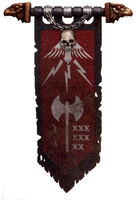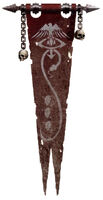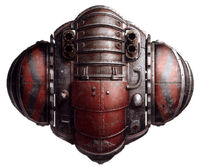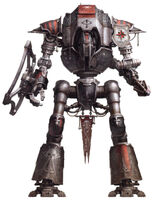House Ærthegn (pronounced Ay-ER-thay-en), known also by its older name of Wræken Dreor in its autochthonic household language, was a Renegade Knight house loyal to the Warmaster Horus during the latter years of the Great Crusade and the Horus Heresy in the late 30th and early 31st Millennia. Accepted amongst the ranks of the Imperial Knight houses only by the personal writ of Horus, and treated by their peers with disdain and wary hostility, the Knights of House Ærthegn were masters of the marauder's bloody trade.
Striking unannounced and with overwhelming force, the stark black machines of these border reavers hunted with brutal efficiency first for their own ends, and later under the authority of the Warmaster's command, placing no value on honour duels or other Knightly ideals which have been for so many Terran centuries the cornerstone of a Knight World's culture.
Survival alone on the cold, dark fringe of the galaxy had, by necessity, forced the Knight house to become more fearsome than the monsters that surrounded it, and in the wars of the Heresy was to prove a deadly weapon in the Traitors' arsenal.
History[]
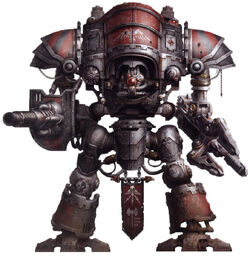
House Ærthegn Colour Scheme as displayed by the Questoris Knight Magaera Kerberos.
The savage warriors known to Imperial records as the Knight House of Ærthegn were first encountered in the northernmost fringes of the galaxy, beyond the edge of the Ultima Segmentum; a region rife with the broken corpses of planets stripped bare by centuries of brutal warfare during the Age of Strife. This desolate region was far removed from the Emperor's advancing armies during the Great Crusade, and the few Rogue Traders and agents of the Imperium to venture into this region and return often brought with them tales of the Wrækan Dreor, a phrase in the curious proto-Gothic dialect of the region which translates as "pilgrims of blood and ashes."
This warrior band were reavers with access to primitive Warp travel through enslaved and tortured psykers, and were known to be the terror of the surrounding stars, descending from orbit with terrible weapons, slaughtering those who opposed them and stripping cities bare of men and materiel before vanishing again into the black depths of the void. As the Great Crusade advanced closer to this bleak frontier during its second century, it quickly became clear to Explorator investigation that the Wrækan Dreor were in fact the descendants of a lost Knight World, much changed by the hardships of Old Night, and while a number of smaller Imperial expeditions fell prey to their depredations, the agents of the Mechanicum were eager to reclaim the house, or if it prove too debased, cleanse and retrieve its engines of war. This, however, was but one matter among many that would be forced to wait for resolution, as the Ullanor Crusade and a dozen other major operations were then fully underway.
It was not until the departure for Terra by the Emperor, and the re-organisation of the Imperium's forces under the strategic command of Horus Lupercal as newly appointed Warmaster, that elements of the Space Wolves Legion were tasked with the subjugation or destruction of the Wrækan Dreor as was warranted, deeming them too dangerous a threat to the safety of the Imperium's northern marches to ignore any longer. However, a series of unexpected Warp turbulence events was to see the punitive Space Wolves fleet unable to make significant headway, with several of its ships lost, and ultimately its orders were countermanded as the Wrækan Dreor attacked Altus Ferro, a world recently claimed by agents of the Mechanicum Forge World of Cyclothrathe.
As the fates would have it, at this time a division of the 63rd Expeditionary Fleet, that of Horus himself, was bound for resupply at the nearby facilities of Port Maw and Manachea, and it was Horus and his Sons of Horus Legion that would answer the call. Confronting the ebon-armoured Knights of the Wrækan Dreor in battle atop the frozen seas of Altus Ferro, Horus is said to have personally torn apart the Knight of the enemy commander, while a phalanx of Justaerin Terminators and Spartan Assault Tanks held back the rest of the foe.
This mighty feat of arms ended the battle and the surviving warriors of the band of Wrækan Dreor, seeing in the Warmaster a powerful lord, swore loyalty to Horus in the traditional manner of their people, naming him their patron and "ring-gifter," and informing him that they were but one band among many of their kind. What was to follow remains unknown, but it is believed that Horus took only a single ship and its company as he travelled into the heart of Wrækan Dreor territory, to the blasted shards of their homeworld where the various bands of Wrækan Dreor fought internecine, savage wars for resources and blood-soaked glory.
With both his own Sons of Horus and the Knights now sworn to his service, the Warmaster embarked on a campaign of diplomacy and controlled violence that pitted each petty warlord against his neighbours, and ended with each band either sworn to serve Horus or scattered and broken in his wake. On his return to Imperial space, the Warmaster's unquestionable authority saw the swift incorporation of the Wrækan Dreor as a Knight House of the Imperium. They were entered in the Imperial College of Arms under the title of "Ærthegn," a name selected from their legends by Horus to represent them to the Imperium. Yet behind the mask of House Ærthegn, these savage warriors remained true to their old ways, prowling the non-Compliant sectors beyond the Imperium's growing borders at Horus' command, honing their skills and awaiting his call to war.
Almost no records exist to tell present-era Imperial scholars of the horrors endured by House Ærthegn during the Age of Strife that forged them into the Wrækan Dreor. Few save the officers of the XVIth Legion and their close allies had met with them other than to bring them to battle, and those records submitted to the Officio Militaris prior to the outbreak of the Horus Heresy have proved, at best, misleading. It is known that the original homeworld of House Ærthegn was destroyed in some unknown calamity, reduced to splintered obelisks of rock to which now cling the barest wisps of atmosphere. The planet's shards formed part of the Hrethmael Drift, which the remnants of House Ærthegn claimed as their warden domain, maintaining an unknown number of heavily fortified complexes buried within them.
That the scattered remnants of this once-proud House possess the technological aptitude to build and maintain such enclaves, as well as their own voidcraft and Knight armours, does much to belie the outwardly primitive appearance and mien of the house's warriors. Each of their enclaves acted as the base for a single sub-division of the house, as well as the storehouse for the multitude of chattels and other supplies seized in the unceasing raids perpetrated by each enclave upon the nearby star systems, both human and xenos. These continuing attacks were the primary method by which the house survived, and such was the competition for resources that fighting between enclaves was a common occurrence, and any sign of weakness a signal to others of their kind to descend and strip the failing enclave bare of usable materiel.
The fighting strength of House Ærthegn was formed into a number of warrior bands, each centred on a single war leader of recognised bravery, martial prowess and, most importantly to the warriors of House Ærthegn, proven generosity fuelled by conquest. The rank-and-file of these warrior bands looked to their Chieftains for both leadership in combat and lavish gifts chosen from the spoils of their raids, and in return were fearless on the battlefield and loyal unto death. Many are the legends amongst the Wrækan Dreor which celebrate loyalty in grim adversity and amongst their wild and savage ranks, oath-breakers are held in particular contempt.
On the battlefield, the warriors of House Ærthegn were little changed from their days as bloody-handed reavers. Horus' attempts to civilise them proved little more than a blind pulled briefly across the eyes of the Divisio Militaris. Led by Chieftains that hold a similar position to the Seneschals of other Knight Houses, the warriors hold the strict hierarchies of others in disdain. Few official ranks exist amongst them, but many of the more experienced warriors hold informal honour titles gained by popular acclaim for their deeds in battle; the younger warriors follow the lead of these veterans, eager to share in their glory. Orders from those outsiders who might consider themselves in authority are rarely heeded, but when one of these veterans advances, his brethren fall in about him, the host reacting to the flow of battle as a pack of wild canids on the hunt.
It is apparent that the incorporation of the Wrækan Dreor into the Imperium as the House of Ærthegn did little to change their brutal ways, and in fact perhaps only served to make them more dangerous under the Warmaster's sponsorship. Contact with the Imperium before the Heresy was conducted almost exclusively by the Sons of Horus and its retainer forces, and the Forge World of Cyclothrathe and a select few Rogue Traders with ties to the Warmaster replenished those weapons of war held by House Ærthegn whose numbers had been depleted by incessant raids and feuding, and restored technologies that time had ravaged.
Unhindered by their appointed Chieftain, Kynerak Gravewalker, whom Horus named as House Master, armed competition between the hosts of the Wrækan Dreor only intensified in order for them to prove their worth both to their Chieftain and their new overlord. Whenever they gained an opportunity to test themselves in bloody duels against other Imperial Knight Houses and Freeblades, the Wrækan Dreor seized them, often offering deliberate provocation in order to ensure such duels were mortal affairs -- a practice which soon gained them a fell reputation with their "allies." Even before the outbreak of the Heresy, there were many who sought that Kynerak suffer official censure, both for the actions of what Horus claimed to be "rogue elements" of the house and his own personal deeds, such as the sacking of the world of Alrus-Legia, where 100,000 citizens only newly brought to Compliance were believed slaughtered or doomed to a lifetime of servitude among the Wrækan Dreor.
The only action taken by Horus to alter the warriors of House Ærthegn was the dispatch of a contingent of Davinite Lodge Priests and Sons of Horus overseers in late 004.M31 to "...aid in their acclimatisation to Imperial culture." These so-called "Crow Priests" seem to have had a profound impact on House Ærthegn, based on the addition of crow symbology to many of their armours. However, rather than strengthening their links to the Imperium, this would appear to have only strengthened their loyalty to the Warmaster and played a role in their later descent into madness and flight beyond the bounds of Imperial vengeance.
Notable House Ærthegn Knights[]
- Kerberos - A Questoris Knight Magaera seized in battle from House Atrax at the height of the fighting on Numinal, the Maegera class armour Kerberos bore the heraldry of the Ærthegn Chieftess Ædalfae Red-wroth. Ædalflae's warband was one of the few to spurn Horus' attempts to dominate their house, returning to the old reaving ways of the Wrækan Dreor. Bloody raids by Ædalflae and other bands of Wrækan Dreor were to be a constant thorn in the side of both Cyclothrathe and Agathaon forces during the fighting in the Coronid Deeps.
- Great Thunoz - A Cerastus Knight-Lancer, Great Thunoz was recovered from the burning hulk of a Mezoan void ark sacked by a raiding band from House Ærthegn, whose sealed Knight armours allowed them to board and assault the craft while it was still in deep space and far from aid. This Knight armour bore the heraldry of Ærthegn warrior Grædan. Despite official records downplaying the size of House Ærthegn, they proved capable of fielding dozens of rare Knight patterns, like the Cerastus Knight Lancer Great Thunoz depicted below, during the Horus Heresy. Great Thunoz was to participate in multiple raids upon macro-cargo haulers across Ultramar to both cut Loyalist supply lines and secure materiel for the Crusade of Iron. The most audacious of these raids remains that of an assault upon a Legio Lysanda "coffin ship," overcoming the Scions of House Orhlacc tasked with defending the ship and capturing those Titans that remained in their cradles.
Notable House Ærthegn Personnel[]
- Kynerak Gravewalker - Chieftain and appointed House Master of Ærthegn by the Warmaster Horus. Under his leadership, armed competition between the hosts of the Wrækan Dreor only intensified in order for them to prove their worth both to their Chieftain and their new overlord.
- Ædalfae Red-wroth - Chieftess Ædalfae Red-wroth was the Knight pilot of the Questoris Knight Magera Kerberor. Ædalfae's warband were one of the few to spurn Horus' attempts to dominate their House, returning to the old reaving ways of the Wrækan Dreor. Bloody raids by Ædalfae and other bands of Wrækan Dreor were to be a constant thorn in the side of both Cyclothrathe and Agathaon forces during fighting in the Coronid Deeps.
- Grædan - Ærthegn warrior, and Knight pilot of the Cerastus Knight-Lancer Great Thunoz.
House Strength[]
In the years before their unification with the Imperium, the Wrækan Dreor were thought to have operated well over 150 Knights split between sub-factions, supported by a large force of marauder infantry and slave-catchers aboard shuttlecraft and other small atmosphere-capable interface vehicles. While some of those who resisted Horus when he arrived at the hidden home system of House Ærthegn perished in battle, it seems the majority survived, and being the charismatic warlord he was, Horus was able to bind them to his sway rather than needing to destroy them.
As the Knight House was taken into Imperial service, official records submitted to the Divisio Militaris by officers of the Sons of Horus attest that the total fighting strength of House Ærthegn numbered at around 100 Knight armours, mostly of ancient Knight Paladin or Knight Errant designs; an estimate which places them amongst the smaller Knight Houses incorporated into the Imperium of the Tertius-grade. After the beginning of Warmaster Horus' rebellion, it quickly became apparent that these numbers were far from accurate; even as the first fratricidal acts of the Horus Heresy were undertaken, hosts bearing the colours of House Ærthegn, whose numbers were far in excess of those reports held by the Divisio Militaris, were unleashed upon Imperial outposts and isolated garrisons who had declared themselves for Terra, or had held to a naive claim of neutrality. The warriors of House Ærthegn, their numbers concealed at Horus' orders, may have numbered closer to 300, rivalling some of the most ancient and largest Knight Houses that were in Imperial service.
Those few destroyed Knights recovered from battles along the vanguard of Horus' advance across the northern reaches of the Imperium, often Cerastus Knight-Lancer armours of recent manufacture, bore the distinctive marks of the forge-wrights of Cyclothrathe. That such forces were concealed in plain sight and bolstered with the most advanced of technologies in secret speaks of the hidden subtleties and long planning for the Warmaster Horus' rebellion.
It is, however, quite possible that these suppositions and reports do not hold the whole truth. Several reports from embattled Loyalist commands on the northern galactic rim detailed the intervention of bands of Knights whose markings and tactics match those of the Wrækan Dreor of old, before the arrival of the Imperium. Unpredictable and savage, these warriors seem equally likely to set about the annihilation of those fighting under Horus' banner before departing as they are to slaughter both sides and strip the battlefield clean once the fighting ends; yet in the dark days of the Horus Heresy, even the most unpredictable of allies made welcome news.
House Appearance[]
House Colours[]
House Ærthegn has always been known for their austere appearance, disdaining the use of more colourful heraldries of other houses. As such the Ærthegn official colours were recorded as the sable and red of the Wrækan Dreor of old. The patterning of red and black chosen by Wrækan Dreor warriors for their armour follows no known scheme of heraldry recorded by the Officio Militaris College of Arms, with no apparent correlation berween the pattern's complexity and the rank of the bearer.
House Arms[]
The Ærthegn coat of arms was represented by a black and red eight-pointed star on a white background, with the inscription of the House's name, "Ærthegn," displayed prominently beneath it.
House Personal Heraldry[]
Despite the lack of ostentatious decoration or adornment of the Knight mounts, among the barbaric warriors of House Ærthegn is the application of often surprisingly artistic emblems, such as the spread-winged crow applied to their Knights and Honour Banners -- a symbol of prophecy and fate among the Wrækan Dreor. Some Knights would utilise their own personal arms, often depicted by a skull surmounting crossed spears. This combination appears to indicate a position within the House sub-cult of the Anhaga, known among other houses as the Scions Dolorous.
Many of Ærthegn's Honour Banners would depict the emblem of a crow slaying a serpent, synonymous in Ærthegn myth with triumph over adversity; the inclusion of the Eye of Horus into this ancient symbol of victory suggested the impact the Warmaster Horus' arrival had on the Wrækan Dreor. Another notable feature would be the prolific runic inscriptions in the autochthonic script used by House Ærthegn, often displayed prominently on a Knight's carapace plating and greaves. These inscriptions would declaim the bearer's past triumphs in a ritualised and archaic style.
Sources[]
- Adeptus Titanicus - The Horus Heresy: Traitor Legios (Specialty Game), pp. 23-27
- The Horus Heresy Book Four: Conquest (Forge World Series) by Alan Bligh, pp. 130-137

